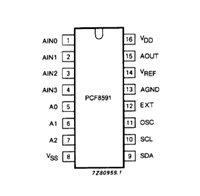AN-19
to the low output and Miller capacitance of the TOPSwitch
internalMOSFET, resultinginfastswitchingtimes. Thesumof
the conduction, CV2f, and crossover losses is 1.39 W for the
TOP214, ascomparedto2.04WforthediscreteMOSFET. The
higher conduction losses of the TOPSwitch are offset by lower
switching losses.
120 VAC, efficiency is between 85 and 87%. Various parts of
this design will be examined with regard to their effect on the
overallefficiencyofthesupply,andtechniqueswillbepresented
for efficiency measurement and optimization.
100
P
= 30 W
o
The TOPSwitch and discrete designs also differ in the amount
of energy that is consumed by the startup and control circuitry.
TheselossesareshowninFigure1. ThelossesintheTOPSwitch
startup circuit are negligible, compared to 30 mW for the
discrete design. The TOPSwitch has an internal startup supply
that is automatically switched off when the TOPSwitch starts
up, so that there are no losses due to the startup circuitry when
TOPSwitch is in operation. Most 3842 and MOSFET power
supply designs use a resistor connected to the high voltage bus
toprovidestartupbiasratherthanthemoresophisticatedstartup
bias circuit shown in Figure 2. Conventional 3842 and
MOSFETsuppliesusing resistivestartupbiaswilldissipate
a constant 1-2 watts in the bias resistor, making the
advantages conferred by TOPSwitch even more apparent.
Controller power consumption for TOPSwitch is much less
than a comparable 3842-based circuit (50 mW vs. 300 mW).
The losses in the controller are due to the power consumed by
the control circuit and the power required for the controller to
drive the MOSFET switch. The TOPSwitch MOSFET is a low
thresholddevicewithlowgatecapacitanceandalmostnegligible
Miller capacitance, resulting in very low drive power
requirements. TheTOPSwitch controllerisalowpowerCMOS
design typically requiring only 5.7 V, 2.5 mA at maximum duty
cycle, and 6.5 mA at minimum duty cycle. All of these factors
contribute to the low power consumption of the TOPSwitch
controller.
90
80
ST204A
70
0
100
200
300
Input Voltage (VAC)
Figure 5. Efficiency vs. Input Voltage, 30 W Output.
Elements of Power Consumption
A power dissipation budget for the ST204A is shown in
Figure 6. Power dissipation was measured for selected
components at input voltages of 90, 120, and 240 VAC, for
30Woutputpower. Duetoinevitableinaccuraciesinmeasuring
and estimating the dissipation of the various components, the
sum of all the individual power loss components is different
from the total power loss as measured at the supply input by
3-4%. A relatively small group of components is responsible
for most of the power loss in the ST204A. These are the input
common mode inductor (L2), input rectifier bridge (BR1),
TOPSwitch (U1), drain voltage clamp Zener (VR1), and the
output rectifier (D2). Other components dissipate a relatively
small amount of power, but have a large effect on the overall
efficiencyofthesupply.Thesearetheinputfiltercapacitor(C1)
and transformer (T1).
OutputdiodelossesforthediscreteandTOPSwitch suppliesare
roughlythesame. Primaryclampcircuitlossesarelowerforthe
TOPSwitch circuit, due to the higher operating frequency of the
TOPSwitch design. For a fixed value of primary inductance,
higher operating frequency results in lower peak operating
current in the primary, reducing the amount of energy stored in
the leakage inductance and therefore, the power lost in the
clamp circuit. Miscellaneous losses in the TOPSwitch circuit
are higher, due to the higher operating frequency of TOPSwitch
(100 KHz vs. 76 KHz for the discrete design) and the higher
output pre-load current.
Measurement Techniques
Measuring the true efficiency contribution of each component
inapowersupplyisnotalwaysastraightforwardprocess. Inthe
caseoftheST204Aandthecomparisonstudycitedabove,three
measurementtechniqueswereusedtoobtainthepowerbudgets
shown inFigures1and6:directmeasurementwithawattmeter,
calculationfromvoltageandcurrentmeasurements,andtheDC
thermal equivalent method.
TOPSwitch Power Supply Efficiency
For purposes of illustration, a more detailed efficiency analysis
was performed using the ST204A reference design board. The
ST204A is a 15 V, 30 W universal-input flyback power supply
using the TOP204. A complete schematic diagram of this
design is shown in Figure 4. As shown in Figure 5, this design
has an efficiency of 80% or greater at full load over most of the
90-264 VAC operating range. At input voltages greater than
Direct Measurement
Direct measurement of power dissipation is useful mostly for
measuring the overall efficiency of a power supply. This
measurement is best performed with a wattmeter which is
designed to provide the average reading necessary to obtain
A
6/96
4






 STM32F030C6芯片介绍:主要参数分析、引脚配置说明、功耗及封装
STM32F030C6芯片介绍:主要参数分析、引脚配置说明、功耗及封装

 PCF8591数据手册解读:参数、引脚说明
PCF8591数据手册解读:参数、引脚说明

 一文带你了解ss8050参数、引脚配置、应用指南
一文带你了解ss8050参数、引脚配置、应用指南

 深入解析AD7606高性能多通道模数转换器:资料手册参数分析
深入解析AD7606高性能多通道模数转换器:资料手册参数分析
